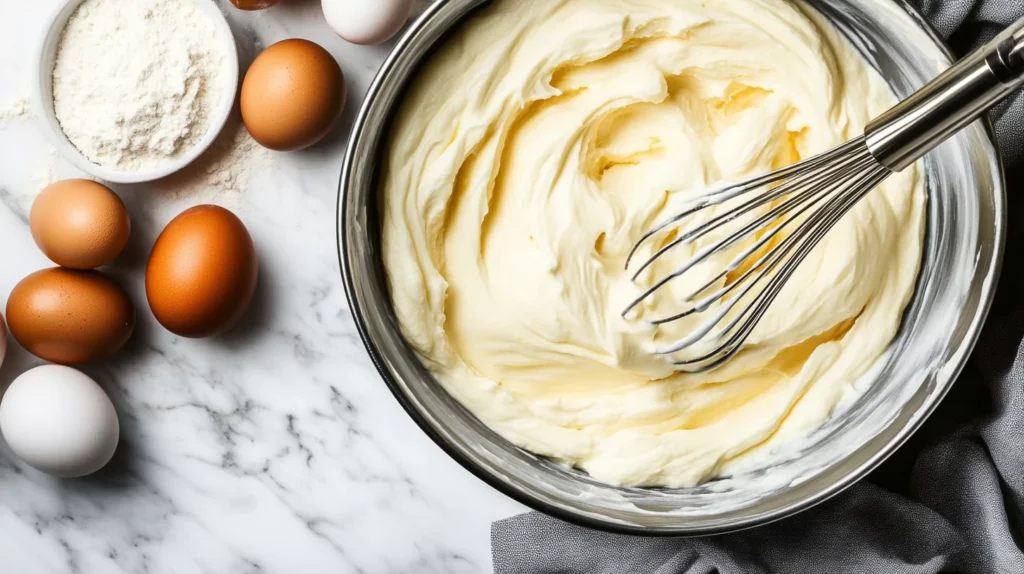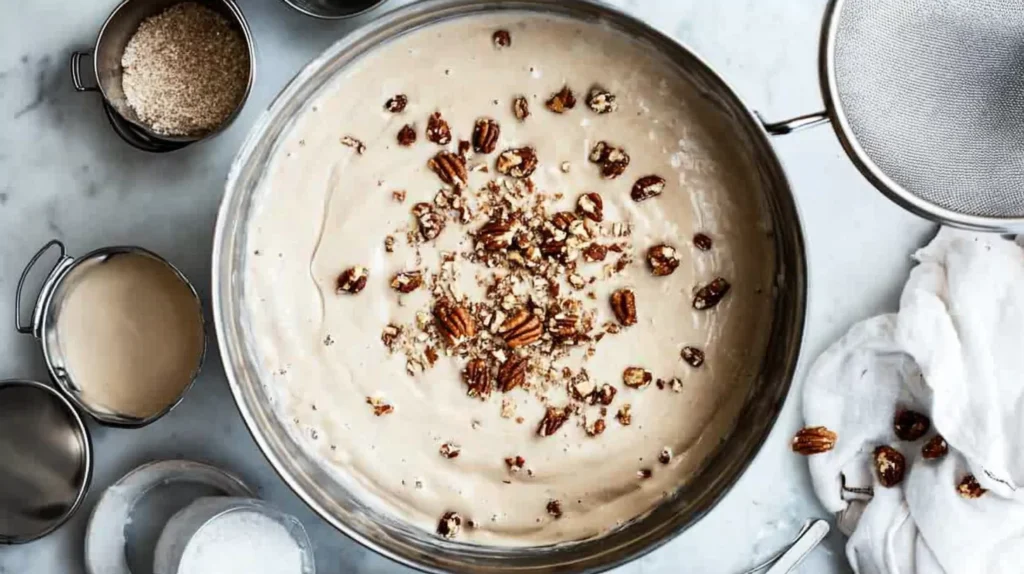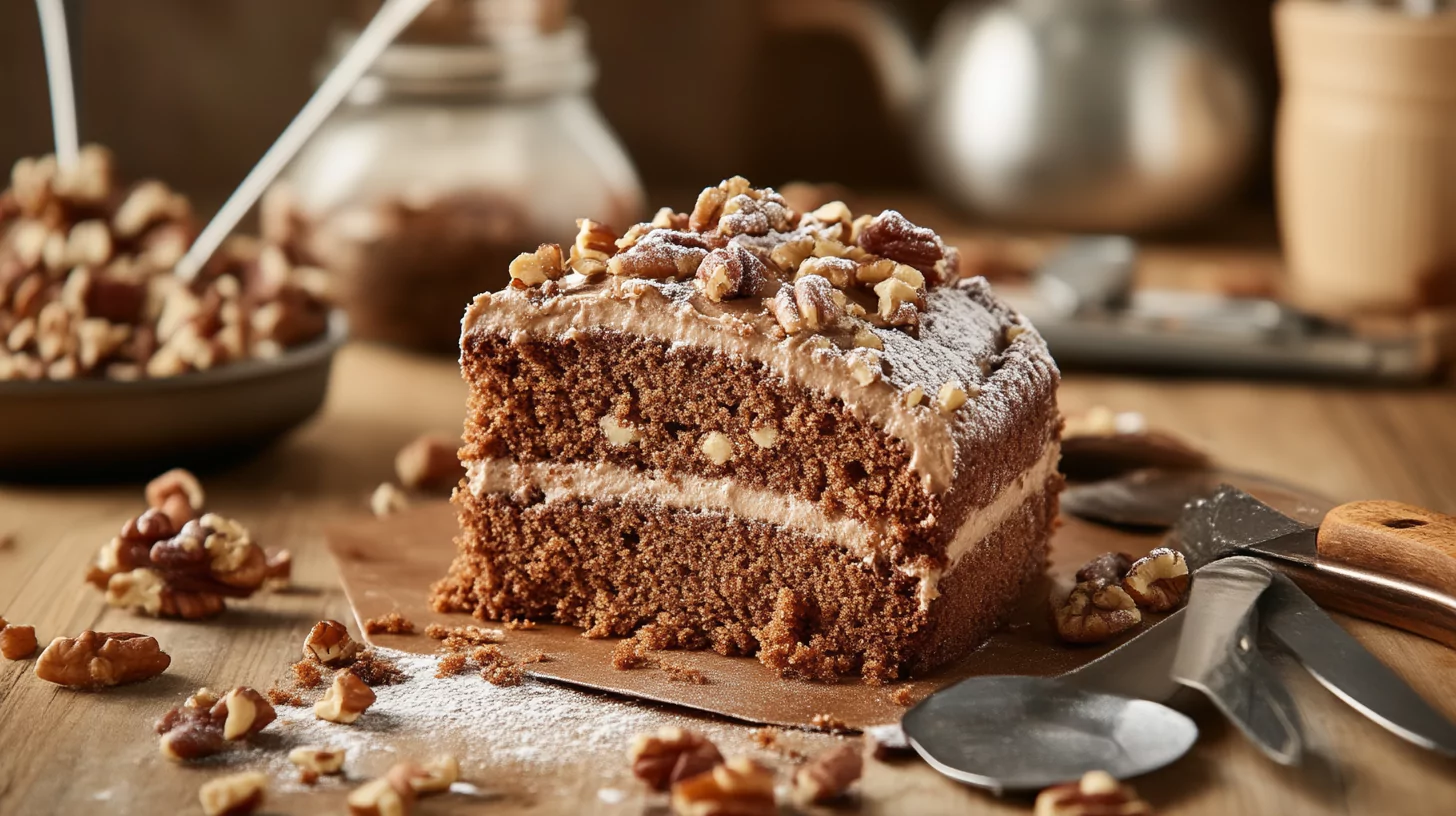How Do You Keep Your Nuts from Sinking in a Cake? Baking a cake should result in a delightful treat that is evenly textured and flavorful, with all its ingredients well-distributed. However, one common baking mishap is nuts sinking to the bottom of the cake. This issue can make your cake less appealing and disrupt the intended texture.
Why does this happen? The sinking of nuts or other mix-ins in a cake often boils down to the science of batter density and preparation techniques. Understanding these factors and learning the right methods can help you avoid this problem and achieve perfect results every time.
In this article, we will explore the reasons nuts sink in cake batter and provide practical, foolproof tips to prevent it. Whether you’re an experienced baker or just starting, you’ll find valuable advice to keep your cakes picture-perfect. If you’re looking for more insights on creating moist cakes, check out What Is the Secret to Super Moist Cake?, discover What Is the Secret to Baking with Almond Flour?, or learn What Flavor Goes Well with Almond Cake?.
Understanding the Science of Cake Batter
Baking is both an art and a science. The texture, structure, and overall appearance of a cake are influenced by the chemical and physical reactions of its ingredients during the baking process. To understand why nuts sink in a cake, we must first delve into the science of cake batter.

The Role of Batter Consistency in Preventing Nuts from Sinking in Cake
The density and viscosity of your cake batter play a crucial role in determining whether nuts or other mix-ins stay suspended or sink to the bottom. A thinner batter with low viscosity allows heavier ingredients to sink more easily due to gravity. On the other hand, a thicker batter with a robust structure can support the weight of nuts and keep them distributed throughout.
The key to achieving the right consistency lies in balancing the wet and dry ingredients. If there’s too much liquid (like milk, water, or oil) compared to flour, your batter may become too runny. Similarly, an under-whipped batter can lack the air pockets that provide structure, resulting in a sinking problem.
Key Ingredients to Keep Nuts from Sinking in Cake Batter
Each ingredient in a cake batter contributes to its overall texture and density.
- Flour: This is the primary structure-building component. Using the right type and amount of flour ensures a sturdy batter that can hold nuts in place. For example, all-purpose flour typically works better for cakes with mix-ins than cake flour, which creates a softer, more delicate batter.
- Eggs: Eggs act as a binding agent. Properly beating eggs can help create a stable structure that prevents sinking.
- Leavening Agents: Ingredients like baking powder and baking soda create air pockets in the batter during baking. However, overusing these agents can cause the batter to rise and fall too quickly, leaving nuts stranded at the bottom.
- Fat and Sugar: Butter and sugar contribute to the batter’s richness and texture. Over-creaming these ingredients can make the batter too light, causing nuts to settle.
Understanding how these ingredients work together helps you control the batter’s thickness and density, setting the stage for success.
Common Mistakes Leading to Sinking Nuts
Even with a well-prepared batter, certain mistakes can lead to sinking nuts in your cake. Avoiding these pitfalls is essential to achieving the desired texture and appearance. Let’s dive into the most common errors that can cause this issue.

Why Heavy Ingredients Make Nuts Sink in Cake Batter
Nuts, by nature, are denser than most cake batters. When they are simply added into the mixture without any preparation, their weight causes them to sink to the bottom during baking. This issue is compounded if you’re using whole nuts, as they are significantly heavier than chopped pieces.
- Whole Nuts: These are bulkier and have a greater chance of sinking unless the batter is dense enough to hold them in place.
- Uncoated Nuts: Tossing nuts into the batter without coating them in a light layer of flour or another dry ingredient reduces their grip within the batter.
How Improper Mixing Causes Nuts to Sink in Cake
The way you incorporate the nuts into the batter matters. Stirring them in too aggressively can disrupt the batter’s structure, causing it to lose the air pockets that support the nuts. Additionally, overmixing the batter itself can lead to a dense and heavy cake that doesn’t bake evenly.
Ignoring Batter Density
As previously mentioned, the thickness of the batter is crucial. A thin or overly liquid batter lacks the structural integrity to hold nuts or other heavy mix-ins in place. This issue can arise from:
- Adding too much liquid (milk, water, or oil).
- Using insufficient flour or over-measuring liquid ingredients.
- Under-whipping eggs or failing to properly aerate the batter during preparation.
Skipping Key Preparation Steps
In baking, attention to detail is everything. Skipping key steps such as pre-coating the nuts, using room-temperature ingredients, or properly sifting the flour can negatively affect the batter’s ability to hold mix-ins. Small oversights like these often lead to disappointing results.
Effective Tips to Prevent Nuts from Sinking
Preventing nuts from sinking in a cake requires simple yet effective techniques that address batter consistency, nut preparation, and baking methods. Implementing these tips will ensure an even distribution of nuts throughout your cake.
How Tossing Nuts in Flour Prevents Sinking in Cake Batter
One of the easiest and most reliable methods to prevent nuts from sinking is to coat them in a light dusting of flour before adding them to the batter.
- How It Works: Flour creates a barrier around the nuts, helping them grip the batter and stay suspended during baking.
- Steps:
- Measure the required amount of nuts.
- Sprinkle a tablespoon of all-purpose flour over the nuts.
- Toss them gently until each nut is lightly coated.
- Fold them into the batter gently to avoid disturbing the flour coating.
This method works for other mix-ins like dried fruits, chocolate chips, and berries too.
Adjust the Cake Batter
If your batter is too thin, the nuts will naturally sink. Making minor adjustments to the batter’s thickness can help.
- Reduce Liquid Ingredients: Slightly reduce the amount of milk, water, or oil in the recipe to achieve a thicker consistency.
- Add More Flour: Add a small amount of extra flour (one or two tablespoons) to create a denser batter.
- Incorporate Yogurt or Sour Cream: Replacing part of the liquid with yogurt or sour cream can thicken the batter and enhance its ability to hold nuts.
Fold Nuts into the Batter Correctly
The method you use to incorporate nuts into the batter also matters. Aggressive mixing can knock air out of the batter and disrupt its structure. Instead, use the following approach:
- Once your batter is ready, sprinkle the flour-coated nuts evenly over the top.
- Use a rubber spatula to gently fold the nuts into the batter with sweeping motions.
- Avoid overmixing to maintain the batter’s aeration and structure.
Layer the Nuts Strategically
Instead of mixing nuts directly into the batter, you can create layers of nuts to ensure even distribution.
- How to Do It: Pour half of the batter into the baking pan, sprinkle a layer of nuts over it, and then pour the remaining batter on top. This method keeps the nuts suspended in the middle of the cake.
- Pro Tip: Add a small amount of batter over the nuts before baking to “seal” them in place.
Use Smaller or Chopped Nuts
Large, whole nuts are more likely to sink due to their weight and size. Chopping the nuts into smaller pieces reduces their density, making them less likely to sink.
- Advantages of Chopped Nuts:
- Easier to distribute evenly.
- Provide a better texture in every bite.
- Blend seamlessly with the batter.
Cool the Batter Slightly
If your batter is warm or overworked, it may lose its ability to hold the nuts. Letting the batter rest for a few minutes before adding the nuts can help thicken it slightly, improving suspension.
Creative Alternatives for Incorporating Nuts
If traditional methods don’t suit your needs or you want to try something new, there are alternative ways to incorporate nuts into your cake without worrying about them sinking. These creative approaches ensure that nuts are not only evenly distributed but also add a unique texture and visual appeal to your cakes.
Create Nutty Layers
Layering nuts in specific sections of your cake is a foolproof way to avoid sinking issues.
- How It Works: Instead of mixing nuts into the batter, you create distinct layers of nuts in the cake, ensuring they stay evenly distributed.
- Steps to Follow:
- Pour a portion of the batter into the prepared baking pan.
- Add a thin, even layer of nuts over the batter.
- Pour more batter to cover the nuts, and repeat the process if needed.
- Bake as directed.
This technique works particularly well in loaf cakes, coffee cakes, and layered cakes where the visual appeal of nuts is part of the presentation.
Use Nuts as a Topping
Another effective method is to place nuts on top of the cake rather than mixing them into the batter.
- Benefits:
- Nuts toast beautifully during baking, adding a crunchy texture and rich flavor.
- You can create decorative patterns or scatter them randomly for a rustic look.
- Pro Tip: To prevent nuts on the surface from burning, cover the cake loosely with foil during the last 10-15 minutes of baking.
Incorporate Nuts into Frosting
For cakes that are frosted after baking, nuts can be added to the frosting for a deliciously crunchy finish.
- Ideas:
- Mix finely chopped nuts into buttercream or cream cheese frosting.
- Use nuts as a garnish on top of frosted cakes for an elegant look.
- Add whole or halved nuts around the edges of the cake for a professional touch.
Bake Nuts Into a Crust or Base
For cheesecakes or dense cakes, you can use nuts as part of the crust or base instead of incorporating them into the batter.
- Steps to Make a Nutty Crust:
- Crush nuts into small pieces or blend them with other crust ingredients like graham crackers or biscuits.
- Mix the nuts with melted butter and sugar.
- Press the mixture firmly into the bottom of your baking pan before adding the batter.
This approach adds a delightful crunch to each slice without the risk of sinking.
Experiment with Nut Flours and Pastes
If you’re concerned about texture, consider substituting part of the flour in your recipe with nut flour (like almond or hazelnut flour). Alternatively, you can use nut butter or paste for a rich, nutty flavor throughout the cake.
- Advantages:
- Nut flours blend seamlessly with the batter.
- Nut butters add creaminess and an intense nut flavor.
- Both options prevent uneven distribution of nuts in the cake.
Troubleshooting and FAQs
Even with careful preparation, you may encounter issues with nuts sinking or other related problems. This section addresses common questions and provides practical solutions to ensure your cakes turn out perfectly every time.
Why do my nuts sink even when I coat them in flour?
Coating nuts in flour helps prevent sinking, but it’s not foolproof if other factors are at play. The most common reasons include:
- Thin Batter: If the batter is too runny, even flour-coated nuts may sink. Try thickening the batter by reducing liquid ingredients or adding more dry ingredients.
- Overmixing: Aggressively mixing the batter can deflate the structure, making it harder for nuts to stay suspended. Fold the nuts gently into the batter instead.
- Whole Nuts: Large nuts are heavier and harder to suspend. Consider chopping them into smaller pieces for better distribution.
Can I prevent nuts from sinking in a gluten-free cake?
Yes, you can! Gluten-free cakes often have thinner batters due to the lack of gluten. To address this:
- Use a gluten-free flour blend that includes xanthan gum or guar gum for added structure.
- Increase the thickness of the batter by adding a bit more flour or reducing the liquid.
- Toss the nuts in gluten-free flour before folding them into the batter.
Should I toast nuts before adding them to the batter?
Toasting nuts enhances their flavor and adds a delightful crunch. However, it’s not essential to prevent sinking. If you choose to toast them:
- Spread the nuts evenly on a baking sheet.
- Toast them in the oven at 350°F (175°C) for 5-10 minutes until fragrant.
- Let them cool completely before tossing them in flour and adding to the batter.
What type of cakes are best for adding nuts?
Nuts work well in a variety of cakes, but their success often depends on the batter’s density. Examples include:
- Dense Cakes: Banana bread, pound cake, and coffee cake naturally hold nuts well due to their thick batters.
- Layer Cakes: Nuts can be layered between sponge layers or added as toppings.
- Cheesecakes and Crust-Based Cakes: Incorporating nuts into the crust ensures even distribution without sinking.
Can I use other coatings instead of flour for nuts?
Yes! Flour is the most common coating, but other dry ingredients can work as well:
- Cocoa Powder: Perfect for chocolate cakes to match the flavor profile.
- Powdered Sugar: Adds a touch of sweetness and works well for light batters.
- Breadcrumbs or Crushed Cookies: Ideal for dense cakes and unique textures.
How do I fix a cake where nuts have sunk?
If you’ve baked a cake and the nuts have already sunk, don’t worry! Here are a few ways to salvage the situation:
- Trim and Layer: Slice off the bottom of the cake where the nuts have accumulated and use it as a separate layer.
- Repurpose the Cake: Transform the cake into a trifle by layering it with cream and fruits.
- Present It Creatively: Dust the top with powdered sugar or frost it to divert attention from the sinking.
Conclusion
Incorporating nuts into cakes adds a delightful crunch and flavor, but sinking can be a frustrating problem. By understanding the science of batter consistency, avoiding common mistakes, and applying the practical tips outlined in this article, you can ensure your nuts remain perfectly distributed in every slice. For a delicious dessert idea, check out this easy and moist almond nut cake recipe that showcases how well-prepared batter can keep nuts from sinking.
Whether you’re dusting nuts in flour, creating nutty layers, or experimenting with nut flours, there’s a solution for every baker. Use these techniques and enjoy consistently perfect results with your nut-filled cakes. Happy baking!


1 thought on “How Do You Keep Your Nuts from Sinking in a Cake?”